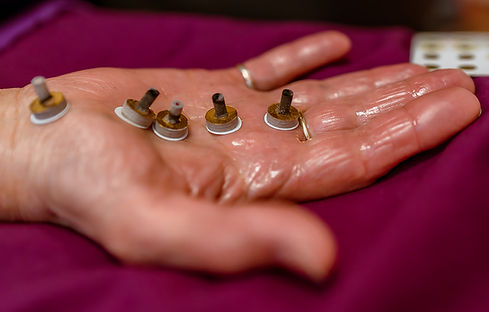Treatment description and therapist thoughts
Korean hand therapy is a diagnostic treatment that is used to identify and treat common ailments. That essentially involves the stimulation of various points through a variety of techniques including:
-
Massage
-
Magnet therapy
-
Press pellet therapy
-
Acupuncture
-
Moxibustion
Most Traditional Eastern medicine is based on the idea that within the body there are meridians, they are essentially highways for your Qi ( Chi), when they get blocked, the Qi can’t flow and it leads to health problems. Traditionally this is solved with acupuncture or moxibustion, although on the hands this can be a little uncomfortable so other less invasive techniques can be used to clear the blockages and helps the Qi flow again.
It’s a lovely therapy and can achieve some great results.


Benefits
-
Good for joint pain and Arthritis.
-
Sciatica
-
Relieves headaches.
-
Reduction of stress hormones
-
Relieves muscle spasms
-
Pain reduction
-
Improved circulation
-
Relieves anxiety.
-
Improved energy
-
Helps with insomnia
-
Helps with digestive issues
-
Greater ability to manage daily stress.
-
Relieved headaches and migraines
-
Relieves tension associated with Stress
-
Potent rapid results
-
Pain reduction in seconds
-
Easily integrated with traditional body acupuncture
-
Safe to use as there are no vital structures or organs in the region of the treatment points that may be damaged inadvertently.
-
Offers a range of non-invasive therapies useful for children and those with mobility problems such as the elderly and disabled.
-
Patients may remain seated and fully clothed.
-
Corresponding points may be used on the hands to avoid traditional points in sensitive or less accessible areas

Therapists
Natalie
Contra-indications
-
Nausea, vomiting or diarrhoea.
-
Fever
-
Broken bones, fractures, dislocations, or severe sprains
-
Contagious diseases
-
Open or unhealed sores or wounds
-
Drug or alcohol intoxication
-
Infectious skin disorders or areas of poor skin conditions
-
Lymphoedema, neutropenia and thrombocytopenia
-
Abnormal bleeding
-
Severe thirst
-
Emotional distress
-
Severe allergic reactions
-
Palliative patients



Title | AM | PM | EVE |
|---|---|---|---|
MON | |||
TUES | |||
WEDS | |||
THURS | |||
FRI | |||
SAT | ✔ | ✔ | |
SUN |
Timing | 60 mins | 90 mins |
|---|---|---|
£53 | £73 |
This treatment is currently only available one Saturday a month with Natalie

History
Korean Hand Therapy (KHT) was discovered by Tai Woo Yoo, OMD, PhD, a South Korean acupuncturist, in 1971, when he found himself unable to sleep with a headache that would not go away. Using a ballpoint pen, he poked an area at the tip of his middle finger which he believed corresponded to the area where his headache was located. He noticed that it was extremely sensitive to pressure. He decided to insert a needle in that area. Dr. Woo cured his headache and was so excited that he proceeded to develop a comprehensive therapeutic system that can be easily learned by anyone.
It is relatively easy to learn and is a perfect healing tool for clinical practice requiring no special equipment other than a dull probe and perhaps some inexpensive pellets that can be purchased and applied to reactive points on the hand corresponding to diseases and pains anywhere on the body.
KHT utilizes acupuncture microsystems on the hand which may not be part of the conventional acupuncture meridians. Traditionally trained acupuncturists can use KHT by finding all the equivalent micro-meridians and points on the hand and treat these instead of inserting needles on the body. Amazingly, the results are equal and immediate.

